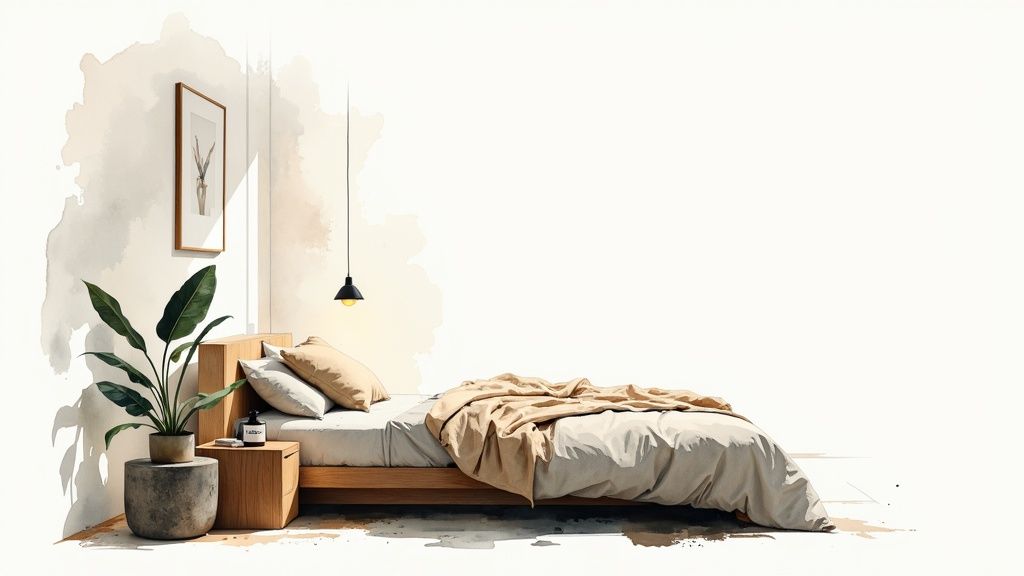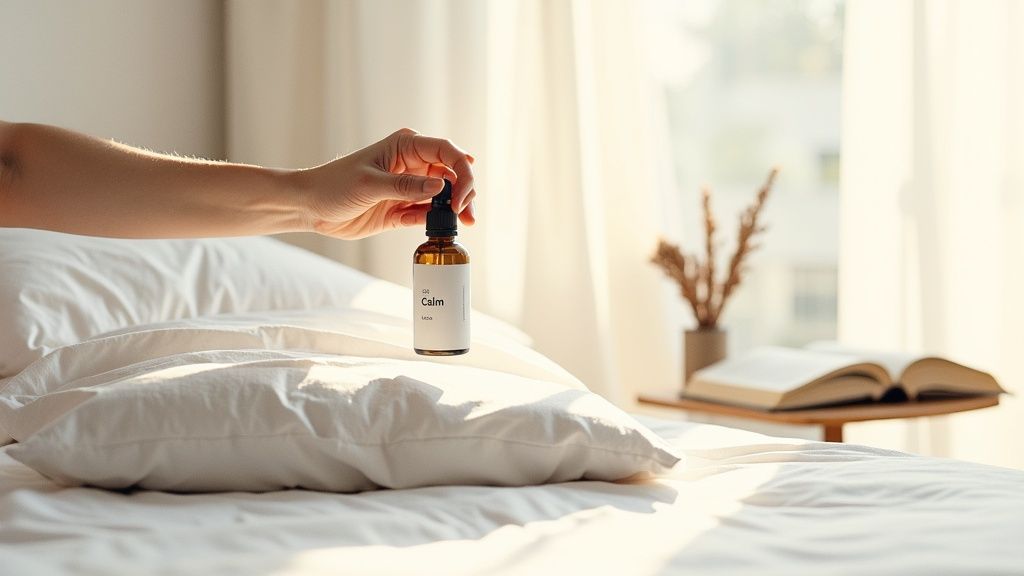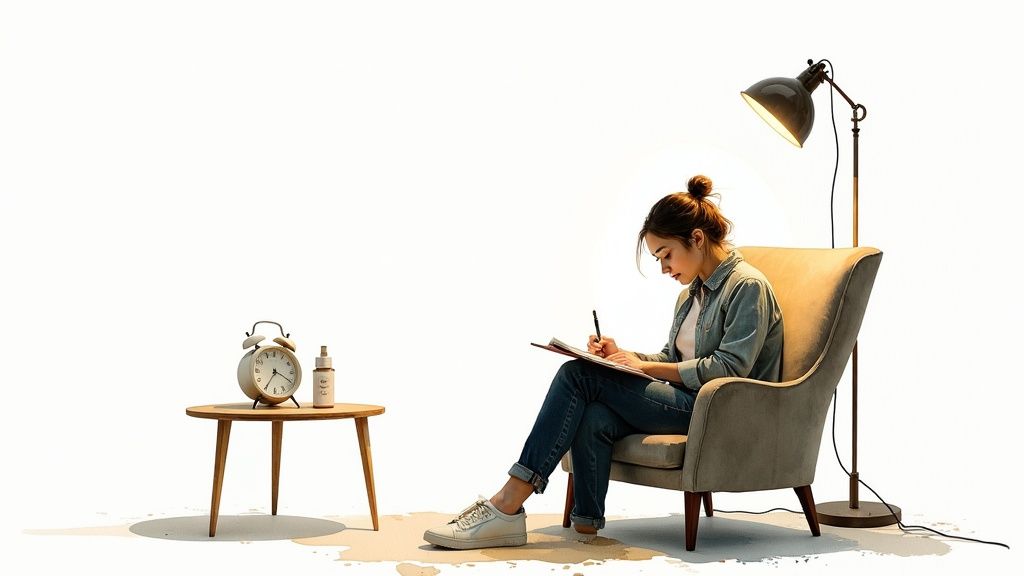
How to Improve Sleep Hygiene: Your Ultimate Guide
by Aerchitect
·
TLDR: To improve your sleep hygiene, focus on three key areas: maintaining a consistent sleep schedule (even on weekends), creating a dark, cool, quiet sleep environment, and establishing a relaxing, screen-free wind-down routine. Simple additions, like using a calming scent from our functional fragrance mists, can create powerful sensory cues that signal to your body it's time to rest.
Learning how to improve sleep hygiene is about creating a consistent set of habits that signal to your body and mind that it's time to rest. This guide will walk you through creating a sleep-conducive environment, building a practical wind-down routine, and making smart daytime choices to ensure a restful night.
What is sleep hygiene and why does it matter?
Sleep hygiene is the collection of habits and practices that are crucial for getting consistent, quality sleep and feeling fully alert during the day. In our hyper-connected world filled with digital noise and constant pressure, understanding how to improve sleep hygiene has shifted from a luxury to a fundamental component of mental and physical well-being.
Think of this as your practical starting point for building better rest habits. We'll explore actionable steps and introduce tools, like our functional fragrance mists, designed to support this journey. Creating sensory cues—like the grounding sandalwood in our Ground mist or the crisp mint in Focus—helps signal to your brain that it’s time to shift gears, whether that's into deep work or deep relaxation.
Why is it so hard to get good sleep today?
The collective struggle for quality rest isn't just a feeling; it's a significant global health issue. When we're sleep-deprived, everything suffers—our mood, productivity, and long-term health. For a deeper look into the science, there are some great resources on understanding sleep and enhancing sleep quality.
The data paints a stark picture of the problem, highlighting just how widespread sleep issues have become and the staggering economic price we pay for them.

These statistics are sobering. A huge portion of the adult population simply isn't getting the necessary rest, which is why figuring out how to improve sleep hygiene has become a serious public health conversation. Over a third of adults worldwide report insomnia symptoms, and in the U.S. alone, the economic cost of insufficient sleep is an astonishing $411 billion annually.
Our environment is a massive piece of this puzzle. The space around us directly influences our emotional state, which is precisely why designing your atmosphere is a core component of reclaiming your rest.
How can you create a true sleep sanctuary?
Your bedroom should be a sanctuary dedicated to rest. Period. Not a secondary office, a gym, or a movie theater. If you’re serious about learning how to improve sleep hygiene, you must begin to see this space as a room with a single purpose: sleep. It’s about consciously controlling sensory inputs—light, sound, and even scent—to send a clear message to your body that it’s time to power down.

This isn't just about preference; it's rooted in what actually keeps people awake. A recent analysis found that the top sleep disruptors for travelers were noise (75%), lighting (72%), and bedding quality (70%). These are the same variables you can master in your own home. For a deeper dive into this trend, the Global Wellness Institute has some great insights on sleep-focused wellness.
How can you control your sleep environment?
Optimizing your bedroom for sleep comes down to a few key adjustments that make a surprisingly large impact. Let's start with the two biggest culprits behind a restless night: light and sound.
- Go Completely Dark. Invest in high-quality blackout curtains or a comfortable eye mask. Even tiny flashes of light from streetlamps or charging electronics can interfere with the production of melatonin—the hormone that governs your internal sleep clock.
- Silence the Noise. If you live on a busy street or have noisy neighbors, a white noise machine can be a lifesaver. Even a simple fan can create a consistent hum that masks sudden, jarring sounds that might pull you out of sleep.
- Dial in the Temperature. Most people sleep best when their room is cool, around 65°F (18.3°C). Experiment with your thermostat for a few nights to find the sweet spot that feels right for you.
A decluttered room leads to a decluttered mind. When you remove work laptops, piles of laundry, and blinking electronics, you eliminate visual stress and reinforce the room’s sole purpose: rest.
The final layer of your sanctuary is scent. This is where you can intentionally set a restful mood before you even get under the covers. A few spritzes of our Ground mist, with its notes of fig leaf, bergamot, and sandalwood, can create a stable, calming atmosphere that anchors your pre-sleep routine. It’s a simple act that makes your entire wind-down feel more purposeful.
How do you build a wind-down routine that works?
A consistent pre-sleep ritual is one of the most powerful tools for anyone serious about how to improve sleep hygiene. It's the essential signal your brain needs to understand that the day is over and it’s time to power down.
Forget rigid, complicated rules. The best routine is the one you’ll actually follow. This isn't about adding another stressful task to your to-do list; it's about intentionally carving out a small pocket of calm for yourself.
Think of it as a flexible menu of screen-free activities you can choose from each night. The only goal is to gently guide yourself away from the day's stimulation and toward a state of genuine relaxation.

This wind-down period is the perfect moment to incorporate aromatherapy. The simple act of spritzing a calming scent can become the final, most potent cue for sleep. Our Calm mist, with its soothing notes of thyme, clove, and sandalwood, was designed for this exact purpose—creating an immediate sense of peace when sprayed on your pillows or in your room.
How do you design a simple wind-down routine?
Creating a routine doesn't need to be a grand production. The real magic is in consistency. By repeating the same small actions night after night, you're building a powerful psychological trigger for rest. It’s a concept we explore more deeply in our article on the psychology of reset rituals.
To make the process feel achievable, here's a sample timeline you can adapt.
Your Evening Wind-Down Blueprint
This is just a starting point—a blueprint you can customize to fit your life. The key is to link simple activities with specific sensory cues, training your brain to recognize that sleep is approaching.
| Time Before Bed | Activity | Purpose and Scent Integration |
|---|---|---|
| 60 Minutes | Dim lights & finish final tasks | Signals melatonin production. Use our Focus mist (eucalyptus, yuzu, mint) to wrap up work without overstimulation. |
| 30 Minutes | Engage in a screen-free activity | Shifts your mind away from digital stimulation. Try reading a physical book or gentle stretching. |
| 15 Minutes | Journal or practice mindful breathing | Processes the day's thoughts to prevent a racing mind. Use our Ground mist (fig leaf, bergamot, sandalwood) to create a calm atmosphere. |
| 5 Minutes | Final sensory preparation for sleep | Lightly spray your pillow with the Calm mist (thyme, clove, sandalwood) as a final, powerful cue for deep relaxation. |
Remember, this is just one example. Feel free to experiment. Maybe your perfect wind-down involves listening to a calming podcast, doing a simple crossword puzzle, or sipping a cup of herbal tea.
Finding a personal routine that you genuinely enjoy isn't just a nice idea—it's the most effective way to figure out how to improve sleep hygiene for good.
How do daytime habits impact your nightly rest?
Thinking about how to improve sleep hygiene isn't just a nighttime activity—it’s a 24/7 commitment. The choices you make from the moment you wake up directly influence how well you rest hours later. Your entire day is a series of opportunities to set yourself up for a successful night.
What you do in the morning, for instance, can calibrate your internal clock for the entire day. Getting some natural sunlight shortly after waking is one of the most powerful signals you can send your body. It helps regulate your circadian rhythm, reinforcing the natural cycle of wakefulness and sleepiness.

This connection between daytime choices and nighttime rest is profound. Research shows that a staggering 72% of people with good sleep health reported flourishing in their daily lives. That’s a stark contrast to the 46% of those with poor sleep health who felt the same way. You can read the full research about these well-being findings to see just how tightly our sleep and daily vitality are linked.
How can you manage your energy during the day?
Managing your energy throughout the day is a key strategy for better sleep. This means being mindful of stimulants, physical activity, and how you handle that inevitable afternoon dip.
- Set a Caffeine Curfew: That afternoon coffee might feel necessary, but caffeine has a surprisingly long half-life. I make it a hard rule to cut off all caffeine by 2 p.m. to ensure it's well out of my system by bedtime.
- Embrace Regular Movement: Consistent, moderate exercise is fantastic for sleep quality. Just try to avoid intense workouts within two hours of your bedtime, as the adrenaline rush can make it difficult to wind down.
- Rethink the Afternoon Slump: Instead of reaching for another coffee or a sugary snack, find a healthier way to reset. A quick walk, some stretching, or a refreshing sensory cue can work wonders without sabotaging your night.
For that afternoon slump, I've found our Focus mist to be a game-changer. With bright notes of eucalyptus, yuzu, and mint, it offers a quick mental reset without the caffeine that can disrupt sleep later. This aligns with a holistic approach to improving focus and concentration throughout your day.
What should you do when you can’t fall asleep?
We’ve all been there. You’re exhausted, you’ve done everything right, but your brain just won’t switch off. Tossing and turning only ratchets up the anxiety, making sleep feel even more impossible.
The single most important rule? Don’t force it.
Instead of fighting a battle you’re destined to lose, the best thing you can do is get out of bed. This strategy, often called the "20-minute rule," is a cornerstone of good sleep hygiene because it stops your brain from associating your bed with frustration and wakefulness.

What is the 20-minute reset rule?
The idea is simple: if you’ve been lying awake for what feels like 20 minutes, get up. Move to another room and do something quiet and relaxing in very low light. This simple act is surprisingly powerful—it breaks the cycle of stress and gives your mind a clean slate.
So, what should you do during this reset?
- Read a real book (not a screen) under a dim lamp.
- Listen to calm music or a quiet, meandering podcast.
- Do some gentle stretches to release any physical tension.
- Jot down your thoughts in a journal to get them out of your head.
The key is to avoid anything that signals "daytime" to your brain. That means no phones, no TV, and no bright lights. You’re aiming for calm, not stimulation.
Don't fight sleeplessness. Your bed should be a place for rest, not a battleground. Get up, reset in a calm environment for a few minutes, and then try again. This breaks the cycle of anxiety and protects your positive association with sleep.
Once you start to feel genuinely sleepy again, head back to bed. This is the perfect moment to reset your sensory environment, too. You can anchor this new attempt with a fragrance designed for rest. A light spritz of our Aerchitect Calm Fragrance Mist with its notes of thyme, clove, and sandalwood can help signal to your brain that it's safe to relax and let go. This isn't about forcing sleep; it’s about gently guiding your body back toward it.
FAQs: Your questions on how to improve sleep hygiene answered
As you start dialing in your sleep hygiene, a few common questions always seem to pop up. Getting clear, straightforward answers is the key to refining your routine and making these new, healthier habits stick for the long haul.
Let's tackle some of the most frequent ones.

How long until I notice better sleep?
While some changes, like a darker room, can offer an immediate payoff, the real magic happens with consistency. Give your body a solid one to two weeks to fully adapt to a new, regular schedule. Sticking to your routine—even on weekends—is the fastest way to reset your internal clock and truly improve sleep hygiene.
Is using a blue light filter on my phone enough?
A blue light filter is certainly better than nothing, but the content you're consuming is often the bigger issue. Social media, breaking news, and late-night work emails are all mentally stimulating and can kick your stress response into high gear. The most effective strategy? Make your bedroom a strict no-screen zone to truly protect your peace.
How does scent help with sleep?
Scent has a powerful, direct connection to emotion and memory. Aromatherapy using calming scents like sandalwood (found in our Calm and Ground mists) or thyme and clove (in our Calm mist) helps trigger a relaxation response. Over time, this trains your brain to associate specific fragrances with rest, making it easier to wind down.
Beyond just observing habits, understanding your biometrics through personal data can offer deeper insights into what’s really going on with your sleep patterns. You can also learn more about the science of scent and mood to see just how powerfully fragrance influences relaxation.
Ready to create a calming atmosphere for your nightly routine? Explore the functional fragrance mists from Aerchitect and find the perfect scent to anchor your wind-down ritual. Visit us at https://aerchitect.com.
